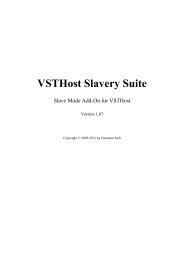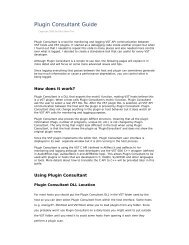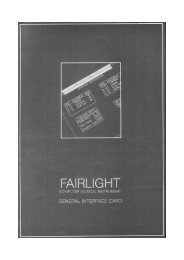VSTHost - Hermann Seibs Hauptseite
VSTHost - Hermann Seibs Hauptseite
VSTHost - Hermann Seibs Hauptseite
You also want an ePaper? Increase the reach of your titles
YUMPU automatically turns print PDFs into web optimized ePapers that Google loves.
Bank Creates an outgoing CC#0 (and eventually CC#32)<br />
message. This can be either a 7-bit or 14-bit message.<br />
Program Creates an outgoing Program Change message.<br />
CC Creates an outgoing CC message. This can be either a<br />
7-bit or 14-bit message.<br />
RPN Creates an outgoing RPN message bundle.<br />
NRPN Creates an outgoing NRPN message bundle.<br />
Pitch Creates an outgoing Pitch Wheel message<br />
Note On Key Creates an outgoing Note On message’s key. The<br />
velocity is defined by #.<br />
Note On Velocity Creates an outgoing Note On message’s velocity. The<br />
key is defined by #.<br />
Note Off Key Creates an outgoing Note Off message’s key. The<br />
release velocity is defined by #.<br />
Note Off Velocity Creates an outgoing Note Off message’s velocity. The<br />
key is defined by #.<br />
Poly Aftertouch Key Creates an outgoing Polyphonic Aftertouch message’s<br />
key. Not many attached keyboards will be able to<br />
Polyphonic<br />
Aftertouch<br />
deliver this. The aftertouch pressure is defined by #.<br />
Creates an outgoing Polyphonic Aftertouch message.<br />
Not many attached keyboards will be able to deliver<br />
this. The key is defined by #.<br />
Channel Pressure Creates an outgoing Channel Pressure message.<br />
Clock This doesn’t really make much sense – although a<br />
specially crafted PlugIn might put it to use. The<br />
parameter value, whatever it is, triggers a single MIDI<br />
Clock (F8) realtime message.<br />
Start, Continue, Stop These also don’t make much sense in a normal<br />
environment. The parameter value, whatever it is,<br />
triggers a single MIDI Start, Continue, or Stop<br />
realtime message.<br />
Then, there are the “CC Relative” types; these are not part of the official MIDI<br />
specification, but have been added by some companies to augment their<br />
product’s capabilities in a makeshift, non-standardized way. They were<br />
implemented to use the new features provided by rotary encoders, something<br />
that simply wasn’t available when the MIDI standard was created. Using these<br />
encoders, you can pass relative controller changes to the program. This is a<br />
very nifty feature – you can send “increment the value a little” or “decrement<br />
value a little more” messages from an external controller. Unfortunately,<br />
there’s no standard for this kind of message, so just about each major player did<br />
it in his own way… that’s why the modern controllers that can send Relative<br />
CC (for example, Behringer BCR-2000/BCF-2000, Doepfer Pocket Dial)<br />
normally provide more than one way to send them. Since I happen to own a<br />
Behringer BCR-2000, the types below correspond to the BCR-2000’s “Relative<br />
1”, “Relative 2”, and “Relative 3” modes.<br />
CC Relative 2C Relative changes are sent as 2’s-complement<br />
numbers. This is the mode used by Steinberg<br />
products, for example.<br />
CC Relative Bin Relative changes are sent as binary values, with an<br />
offset (64 in 7-bit mode and 2048 in 14-bit mode).<br />
CC Relative SB Relative changes are sent with a dedicated sign bit; in<br />
7-bit mode, bit 6 is the sign bit, and in 14-bit mode,<br />
bit 13 is the sign bit. If set, the number is negative.<br />
This is the mode used by Apple/eMagic Logic, for<br />
example.<br />
# For some types, an additional number can be given; for example, for CC<br />
48





